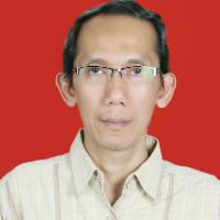
Agus Ganda Permana
Work place: Telecommunication Technology, Telkom University, Bandung, 40257, Indonesia
E-mail: agusgandapermana@telkomuniversity.ac.id
Website: https://orcid.org/0009-0003-6726-4983
Research Interests:
Biography
Ir. R. Agus anda Permana, M. T.. Born in Jakarta, in 1962. Earned his Bachelor's and Master's degrees in Electrical Engineering, Faculty of Industrial Engineering, National Institute of Science and Technology (ISTN), Jakarta. In 1991 he worked at STT Telkom (now Telkom University) as a teaching staff with NIDN.0030076201 in the Electrical Engineering Department (now placed in the Faculty of Applied Sciences in the Telecommunication Technology study program) with the functional position of Senior Lecturer (IVB). Currently actively involved in the Smart Technology Applied Science Research Group (STAS RG), Applied Information Technology and Multimedia (AITM) expertise group and the Smart Indonesian Teacherpreneur Association (PTIC).
Author Articles
Cocoa Land Mapping Based on Geographic Information System in East Kalimantan Using Leaflet JS and GeoJSON
By Reza Andrea Agus Ganda Permana Aulia Khoirunnita
DOI: https://doi.org/10.5815/ijeme.2025.06.05, Pub. Date: 8 Dec. 2025
East Kalimantan Province holds significant potential in developing cocoa commodities, a key sector in regional plantation development. However, there is a lack of an effective, web-based information system to visualize and manage data related to cocoa land distribution. This limitation hampers access for both the public and policymakers. To address this issue, a web-based Geographic Information System (GIS) application was developed using Leaflet JS and GeoJSON. This application aims to provide an interactive map that can display the location of cocoa plantations in the distribution of East Kalimantan Province, especially in Kutai Kartanegara, East Kutai, West Kutai, Mahakam Ulu, Penajam Paser Utara, Paser, Berau, Samarinda, Balikpapan, and Bontang, as well as providing information about the land area and cocoa production. Spatial data and cocoa production data are integrated into this application so that users, including farmers, entrepreneurs, and governments, can obtain comprehensive information about cocoa commodities in the East Kalimantan Province. By visualizing cocoa land distribution, the GIS tool is expected to support informed policymaking aimed at improving productivity and land use efficiency. It also serves to raise public awareness of cocoa potential in local communities.
[...] Read more.Enterprise Architecture Design at PT Perkebunan Kaltim Utama Using TOGAF ADM
By Agus Ganda Permana Reza Andrea Imron Aulia Khoirunnita
DOI: https://doi.org/10.5815/ijeme.2025.05.02, Pub. Date: 8 Oct. 2025
Information systems and information technology have become indispensable in modern business operations, serving as critical tools for enhancing efficiency, streamlining processes, and supporting strategic decision-making. To ensure these technologies effectively meet organizational needs, enterprise architecture design plays a key role in aligning business goals with IT systems. This alignment not only improves operational efficiency but also lays the foundation for long-term organizational success. This study employs The Open Group Architecture Framework (TOGAF), focusing on its Architecture Development Method (ADM), to design an enterprise architecture tailored for PT Perkebunan Kaltim Utama. TOGAF ADM offers a structured, iterative approach to architecture development, encompassing phases from the initial planning stage to the final design and implementation analysis. Each phase is designed to integrate business processes with IT systems, enabling a cohesive and adaptive framework. PT Perkebunan Kaltim Utama, a company specializing in palm oil mill maintenance, faces significant operational challenges due to its reliance on manual processes and lack of integration. These inefficiencies hinder productivity and affect the company’s ability to meet strategic goals. This research systematically identifies the functional and technological requirements for PT Perkebunan Kaltim Utama’s business activities, laying the groundwork for an integrated solution. The proposed architecture design addresses these inefficiencies by providing a comprehensive blueprint for implementing a unified system. This system will not only enhance PT Perkebunan Kaltim Utama’s operational performance but also support its strategic objectives, enabling the company to remain competitive and responsive to industry demands. By integrating TOGAF ADM into its processes, PT Perkebunan Kaltim Utama can ensure a more effective alignment of business and IT, paving the way for sustainable growth and improved decision-making capabilities.
[...] Read more.Designing an Engaging Mangrove Ecotourism Website for Bontang Mangrove Park Using the RUP Method
By Nataniel Dengen Reza Andrea Agus Ganda Permana Suswanto
DOI: https://doi.org/10.5815/ijieeb.2025.05.06, Pub. Date: 8 Oct. 2025
Bontang Mangrove Park located in Kutai National Park, North Bontang District, Bontang City, serves as a prominent mangrove forest tourism destination. Despite its popularity, the park lacks an official website, relying solely on social media for information dissemination. This limitation restricts the park's ability to reach a broader audience and provide comprehensive details about its facilities, operational hours, and attractions. To address this issue, a dedicated website was developed to enhance the park's online presence and improve visitor accessibility to information. The website design and development followed the Rational Unified Process (RUP) methodology, an iterative and incremental approach to software development that ensures adaptability to changing functional requirements. Functionality testing was conducted using the Black-box method, while user satisfaction with the website's design and usability was assessed through a Likert-scale questionnaire distributed to 100 participants, indicating a positive reception with 74.03% of respondents rating the website favorably. This rating classifies the website as "Good" in terms of functionality and user experience, demonstrating its potential as a valuable tool for promoting mangrove ecotourism in Bontang Mangrove Park. The findings highlight the website's ability to improve accessibility, promote ecotourism, and engage visitors through digital means.
[...] Read more.Other Articles
Subscribe to receive issue release notifications and newsletters from MECS Press journals